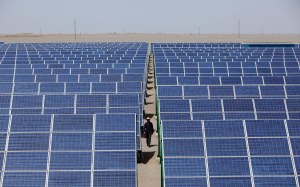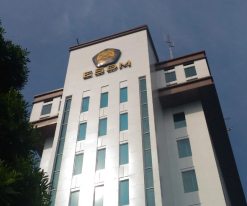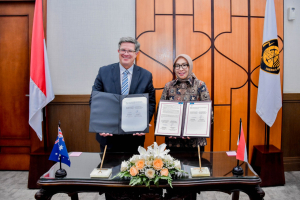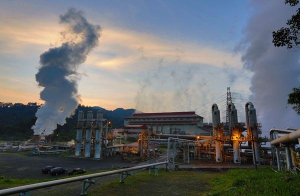Indonesia puts clean energy at heart of economic strategy: ESDM ministry
Indonesia is repositioning clean energy not only as a climate solution, but also a central pillar of its national development strategy, said Dadan Kusdiana, Secretary-General of the Ministry of Energy and Mineral Resources (ESDM).
Addressing the "Mentari Day" event in Jakarta on Thursday, July 3, 2025, Dadan outlined an integrated energy transition vision that combines energy access, sustainability, and economic growth, particularly through industrial downstreaming.
“Energy transition is not just about reducing emissions. For Indonesia, it is about enabling inclusive economic development and boosting competitiveness,” he said. “The only way forward is to view renewable energy as an enabler − not a cost − for national growth.”
The government, he said, is aligning two of its top priorities under President Prabowo Subianto’s leadership: energy security and downstream industrialization.
He argued these agendas must converge to drive a just and rapid transition. “We can’t talk about energy transition in isolation. Downstreaming is how we accelerate it,” he said.
He cited recent milestones, including the launch of a solar panel manufacturing facility and a battery production ecosystem, as examples of how Indonesia is developing clean energy industries at home.
“We have the world’s largest nickel reserves. Now we’re building out the full value chain, from mining to battery manufacturing,” he said. These developments, Dadan emphasized, will allow Indonesia to move beyond being a raw material exporter and position itself as a major player in global clean energy supply chains.
Rural electrification
A core focus of ESDM’s upcoming agenda is accelerating rural electrification, especially in Eastern Indonesia. He acknowledged that significant gaps remain in energy access across regions like East Nusa Tenggara (NTT), and that government programs must close this divide to ensure no one is left behind.
“The eastern region is our last mile. Places like Mata Reddy Village in Sumba are symbolic of the 5,600 villages still lacking adequate access,” Dadan said. “Our goal is to reduce this number one by one − every day, every year − through diverse programs and partnerships.”
He also referenced Sumba Iconic Island, an initiative launched in 2009 to pilot off-grid renewable electrification. Building on that model, ESDM ministry is preparing dedicated budgets and implementation plans − led by the Directorate General of Electricity − to scale up access across similar regions. He emphasized that off-grid renewable systems will play a central role in delivering clean and reliable power where grid extension is not feasible.
Dadan highlighted the importance of institutional sustainability in rural energy projects, drawing lessons from Mentari’s implementation.
“Too often, government infrastructure projects are rushed to meet year-end deadlines. What’s missing is clarity on who manages them, who maintains them,” he noted. “Mentari has shown us the value of community-based models. We must ensure government investments are durable and locally owned.”
Infrastructure, grid modernization
Beyond village electrification, the ministry is investing in grid infrastructure to support the integration of renewables. Dadan revealed that ESDM ministry is planning to build 49,000 kilometers of new transmission lines to connect clean energy sources with demand centers.
“Many of our renewables are far from the load centers. Transmission is the enabler of national energy resilience,” he said.
He reiterated that energy policy must be comprehensive, inclusive, and sustainable, with planning across sectors − fossil fuels, renewables, electricity, and minerals − now fully integrated.
“We no longer treat coal, renewables, or gas as separate silos. Policy development is now conducted in parallel,” he said.
He acknowledged the continued role of coal and gas during the transition, but stressed the need to reduce emissions through technologies like carbon capture and storage (CCS) and co-firing with biomass. On gas, Dadan said new discoveries, especially in Eastern Indonesia, could serve as a transitional bridge while clean technologies scale up.
Exports and industrial development
Dadan also addressed the evolving dynamics of Indonesia’s cross-border electricity trade, particularly with Singapore. He said ESDM ministry is working to ensure that electricity exports do not merely benefit receiving countries but also stimulate domestic industrial development.
“When we export electricity, we must also attract investment,” he said. “We don’t want to be just power exporters. We want to build industries at home that are powered by that clean electricity.”
He cited that this principle guided recent negotiations with Singapore on CCS and sustainable industrial development. “The aim is win-win: Singapore gets clean energy, and Indonesia gets economic and industrial growth. That’s how we multiply the benefits,” he said.
Flexibility and TKDN
Responding to concerns around local content (TKDN) in renewable energy development, Kusdiana urged a balanced approach. “TKDN should not be viewed as a barrier. Yes, we must absorb domestic products, but not at the cost of delaying projects,” he said.
He cited that ESDM ministry is working to align TKDN enforcement with project acceleration, ensuring that local industries grow alongside − not at the expense of − the clean energy transition. He also acknowledged Mentari’s support in providing studies and technical insights for this process.
In closing, Kusdiana rejected the notion that clean energy is economically burdensome. “Renewables are not expensive − they are the growth engine of the future,” he said. “Energy transition is not a cost. It’s an opportunity for Indonesia to leap ahead.”
He called on stakeholders across ministries, regions, and private sectors to carry forward the momentum of Mentari into the next phase. “We’re not here to repeat the past. We’re here to scale it, replicate smarter, and design better programs for greater impact.”
Already have an account? Sign In
-
Start reading
Freemium
-
Monthly Subscription
20% OFF$29.75
$37.19/MonthCancel anytime
This offer is open to all new subscribers!
Subscribe now -
Yearly Subscription
33% OFF$228.13
$340.5/YearCancel anytime
This offer is open to all new subscribers!
Subscribe now







